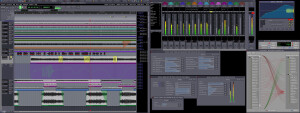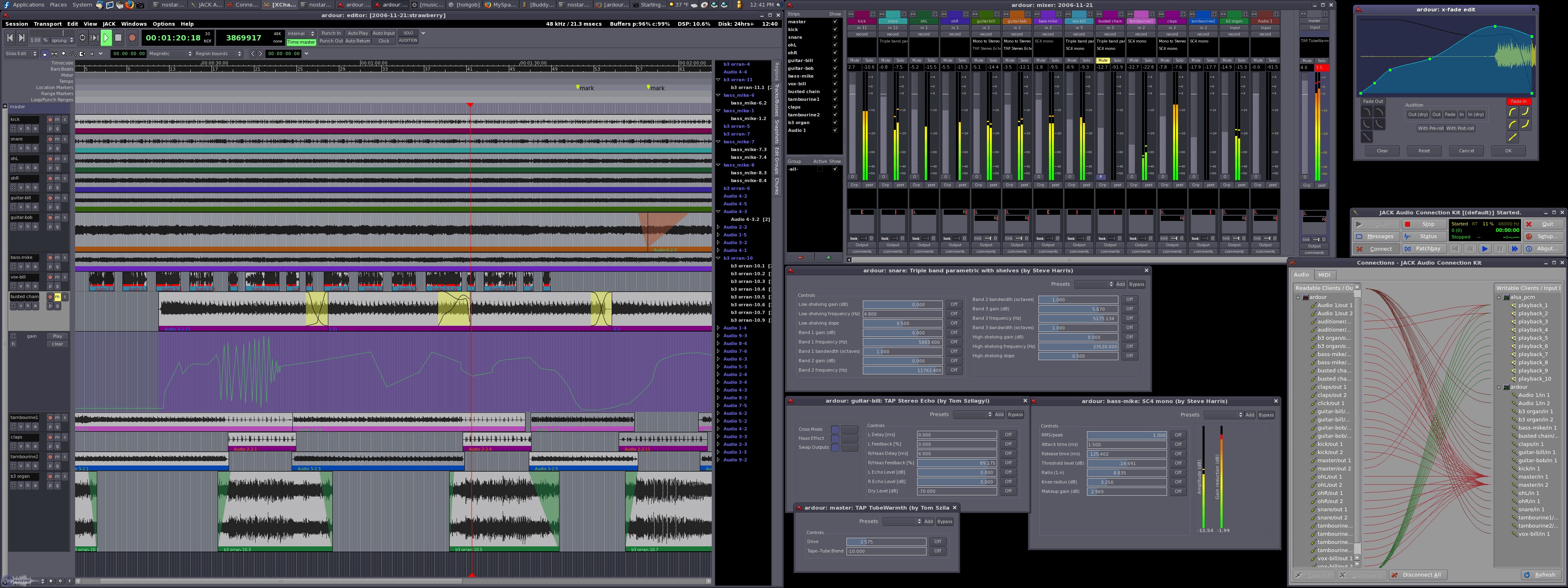Not satisfied with those reviews?
Filter
Our members also liked:
4.8/5(8 reviews)
75 %
25 %
Write a user review
Users reviews
 ttoinePublished on 05/05/07 at 04:09 (This content has been automatically translated from French)I speak here as dveloppeur Ubuntu Studio distribution based on Ubuntu but very popular multimedia oriented production, which will release THE FIRST guides around the audio. https://ubuntustudio.org
ttoinePublished on 05/05/07 at 04:09 (This content has been automatically translated from French)I speak here as dveloppeur Ubuntu Studio distribution based on Ubuntu but very popular multimedia oriented production, which will release THE FIRST guides around the audio. https://ubuntustudio.org
So we've compiled (among others) in Ardour2. Deb package according to the spec packaging for Ubuntu / Debian (just about technical history of once), and therefore, installation is super simple using the installer Synaptic package. Anyone with an Internet connection hight flow can do so, since I recall that installing Linux without a network loses some of its meaning.
Note that Linux, like Mac, support for VST plug-in for Ardour2 is not pr-compilation should pick up the SDK on the websit…Read moreI speak here as dveloppeur Ubuntu Studio distribution based on Ubuntu but very popular multimedia oriented production, which will release THE FIRST guides around the audio. https://ubuntustudio.org
So we've compiled (among others) in Ardour2. Deb package according to the spec packaging for Ubuntu / Debian (just about technical history of once), and therefore, installation is super simple using the installer Synaptic package. Anyone with an Internet connection hight flow can do so, since I recall that installing Linux without a network loses some of its meaning.
Note that Linux, like Mac, support for VST plug-in for Ardour2 is not pr-compilation should pick up the SDK on the website Steinberg, decompress, add in source files, and start the installation manually. A bit technical for beginners, for cons ... This is to license the SDK from Steinberg VST plugins, which is not compatible with some libraries used by Ardour2 that they are GPL (including time-stretching and CSOs)
In contrast, in Linux, there is the architecture of effects "Ladspa", which while not great graphical interfaces, are plug-in dvelopps by universities or researchers in sound processing, and frankly, sounds serious. Forcment not need the VST, then, but we'll have to take time to listen.
The technical part of the installation is the configuration of Jack, the sound server used by Ardour2. Linux, be careful, all professional sound cards are not sandstone. You can learn more these addresses:
- Http://www.alsa-project.org/alsa-doc/ for PCI, PCMCIA and USB
- Http://freebob.sourceforge.net/index.php/List_of_Supported_Devices for firewire cards
NB: Be aware that some cards have SPECIFICATIONS utilities for configuration, but they are included if you install Ubuntu Studio Audio packets. Example, RME.
If your sound card is on the list, so it's as simple as mac: you connect, it works. It only remains for you so that rgler latency, etc ... in jack ... Consider installing qjackctl interface to make your life easier (installed by default with Ubuntu Studio audio packets)
For Mac, all sound cards are sandstone CoreAudio detects and work, it only remains for you that set the latency, etc ...
Coupled "patching" to grate the connections between all terminals and software, and "jackrack" to the effect racks, you can work virtually as in the analog world.
I put a note of trs to install, since there is nothing special about Linux if you do not want to use the VST, which are not really useful given the amount of TRS good plugins.
SUITABILITY/PERFORMANCE
I turned on my Sony laptop, an ultraportable with Intel Centrino quip, and a workstation based on an AMD Athlon X2, 2ghz of RAM memory and hard drive Sataya 3 in 10,000 rev / min , I dveloppe and assembles. The two computers running Ubuntu Studio (the beta version, since I'm dveloppeur)
I have several sound cards, including an RME MultifaceII (PCI and PCMCIA) and an Echo Indigo I / O (pcmcia) and runs really well. Using a Linux kernel optimized for working in low latency, I'm running without problem (no clip, no X-run) card RME 2.67 ms latency, and the card until Echo can Get You Started 1.33 ms, but it's the laptop that does not follow. Basically, working 2.67 ms latency, was running fine on two machines.
With the workstation, I have not really found a limit in terms of number of tracks, unless you really care too much processing.
With the laptop, the LED 8 tracks with effects, clipper started a little when I work in low latency trs. But for mobile recording, I traced back the latency and allows me to record 16 tracks tranquil 8 on a firewire external drive.
It's more than trs stable, low on Linux, which should be remembered, is the leading operating system and high Available turns virtually all web servers, etc. ... It is a ideal solution for working all day long, and do not crash in the middle of a working session (not like some expensive trs whose interface bugue another time, what) .
The software works in wave, you can choose The definition, 24 bit or 32 bit float. Everything is saved in a session file, so one can easily rcuprer all or part of the project if necessary. Everything is saved rgulirement if o is a false manipulation with the Systm, as I recall, has not crash.
So I put the maximum score for this part of the notice.
OVERALL OPINION
I used version 0.99 for quite some time, and version 2 for a few days / weeks since I had had the prmices.
The particularity is that we must learn to configure the server from its jack. Ardour2 does not start if jack is not running and well configured. It's both a good thing because it is the basis of performance in terms of latency and quality of digital summation, but it is a ngatif for people who do not want to discovering a new fawn to work. Once configured not need to touch it, but sometimes you tweak a little beginners. We can save presets depending on what you want to do.
The interface is easy, there is a window for editing, another to the mix, and the menus have finally t simplifies and clarifies. Paul Davis, the author of Ardour and Ardour2, took into account the views of users and the community to this new version trsrussie, easier to take in hand, etc ...
The quality price ratio has no competition: it is free, so free, and the audio is comparable a Pro-Tools, Nuendo, Logic or Samplitude. This especially so dpend your acquisition interface for audio quality of the recording. I recall that there is no limit on number of tracks, unlike most of the paid solutions. I do not have surface CONTRL, but Ardour2 is compatible with Mackie Control, among others.
Namely:
- The audio engine used by Ardour is particularly useful Harrison, a manufacturer of consoles, high-end production by Muse Research for its squenceurs / bass recorders on Linux, and IRCAM for his dveloppements around her.
- Paul Davis, Ardour of the crateur, collaborate with other SSL, and is one of the popes of computer music, whether Linux or not.
- Expect an audio engine therefore cost of a high quality trs trs a wide dynamic range (prparez you decrease the volume of your HP monitor, and this without changing card sound) and a digital summation among the best, if comparisons are made in the studio.
As the Previous version of Ardour sounded really good but not great n'tait use, as the new version is really accomplished. So I prfre dsormais to 1000 in peripherals or a good quality converter than buying a software license equivalent.
Remains that we are on Linux, everything is perfect in terms of interface (Mac compartment, for example), and some applications are around Ardour2 amliorer. So I do not put the maximum.See less20 petitefanfare
petitefanfareArdour 3...being adopted
Published on 08/08/11 at 00:01I chose the Tango Studio Linux distribution... it's easy to install and, more importantly, it was conceived with musicians in mind, not programmers ... low-latency and other configurations that make it ready-to-use.
I tried Ubuntu Studio but I had a hard time with my M-Audio 24/96 soundcard, even though it is recognized by linux ... However, I had no issues under tango studio (thanks to its Alsa configuration)...
I must add, though, that I chose this soundcard because, unfortunately, Linux does not recognize all soundcards, which can be a real pain...
PERFORMANCE
4 gb ram on a 3-year old pc... It would be better to have some more, but...
It has some bugs but nothing to…Read moreI chose the Tango Studio Linux distribution... it's easy to install and, more importantly, it was conceived with musicians in mind, not programmers ... low-latency and other configurations that make it ready-to-use.
I tried Ubuntu Studio but I had a hard time with my M-Audio 24/96 soundcard, even though it is recognized by linux ... However, I had no issues under tango studio (thanks to its Alsa configuration)...
I must add, though, that I chose this soundcard because, unfortunately, Linux does not recognize all soundcards, which can be a real pain...
PERFORMANCE
4 gb ram on a 3-year old pc... It would be better to have some more, but...
It has some bugs but nothing too bad (I must admit that my computer is not very recent and isn't the best for making computer music).
My M-audio soundcard has no preamps. That's why I added a tube-pre (presonus)... which has only one input, but it's better than nothing. I play one instrument after the other (guitar, piano, vocals...)...
It's more than enough together with my Audio technica AT2020 mic.
There are obviously better things out there, but they are more expensive, and I'm not for winning the hardware race.
I think I have good low-cost gear.
What's important is what you do with it (in my opinion).
OVERALL OPINION
In conclusion,
After one month of use, I've almost mastered it and I think it's pretty good.
Pros:
1 It's free but a donation to Paul Davis (ardour's creator) is very welcome....
2 Thanks to the Jack software, you can connect to it a drum machine, an additional synth (already installed under Tango Studio), compressor (jamin)...
3 Plug-ins: Heaps of them...for free.
4 It's easy to get used to it (although I still have lots to learn)...
Cons:
1 Linux doesn't recognize all soundcards, so...
I admit I don't know any other software tools, most of which aren't free, but the times are tough right now...
They are either too expensive and you have to get them illegally... I chose Ardour as a conscience decision.
And after what I've heard... Ardour has not much to envy its paid counterparts... and given the results I get, I don't doubt it (I'm talking about the sound and the huge possibilities it offers).
With hindsight, I'd definitely choose it again...If you're on a low budget, don't think it twice.See less00






